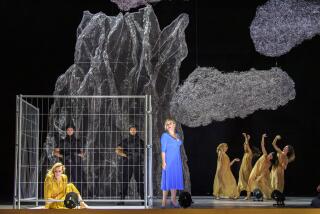English Orpheus in the Literary Underworld : THE MEDUSA FREQUENCY <i> by Russell Hoban (Atlantic Monthly Press: $16.95; 143 pp.) </i>
- Share via
Herman Orff, author of two unsuccessful novels and blocked on his third, supports himself by writing balloon-texts for a classic comics series. He moves about a dingy London, dropping in on his dingy artistic and literary friends while trying to break through to the wellspring of poetic imagination that, until now, has favored him with no more than an erratic cupful.
Then one day, crossing Putney Bridge, he hears a voice crying to itself: “Eurydice!” He looks and sees a head bobbing in the mud flats below. He fishes it out; slimy and barnacled, it belongs to Orpheus the Singer, founder of the line on which Orff is a discouraged, late-20th-Century tuft.
It is the first of several encounters. Orpheus’ head will reappear as a cabbage on a barrow. It will appear as a football. It will appear in Orff’s refrigerator one night as he looks for a snack.
And it will tell its story--tormented creator to tormented creator--that is the centerpiece of Russell Hoban’s comical, sometimes irritating and often quite ravishing tale about art, love and frazzled humanity: a triple set of tragically, mutually erosive reciprocals.
Hoban, whose “Riddley Walker” made an astonishing flight into the minds and speech of prehistoric humans, is a transporting writer. He can shatter expectable rhythms and familiar linkages, yet make his voyages as recognizable as if they took place a town or two away.
“The Medusa Frequency” seems over-arranged sometimes, its strangeness can subside into quaintness, it has a symbolic character or two too many, and its humor takes exaggerated pratfalls in order to make us feel at home with its mysteries. But Hoban has remarkably managed to bring mythological figures, along with various time-warping and surreal devices, up into a thoroughly contemporary scene and make the connections not only credible but illuminating.
We follow Orff through the mud flats of his own consciousness. His spectral encounters and conversations can take on a cheerfully prosaic tone. Apart from Orpheus’ head, there is the Kraken, another mythological creature who communicates through Orff’s word processor. At first, he speaks loftily of being the monster-figure that allows humanity to lodge its primal terrors in a concrete and manageable image. Soon, he is proposing to collaborate on a story idea for a TV series. By the end, this seems likely to go as a cereal-box cartoon strip.
On the other hand, Orff’s everyday perambulations turn mythical. Dealing with his manic publisher by telephone is painful for him; after several abortive calls, the publisher climbs out of the receiver for a brief chat. Orff meets Melanie--one of several versions of his own Eurydice--in a pub, and she greets him with: “Here I am. Did you think I’d come?” A moment later, he is in a nearby church, and she reappears with the identical phrase.
Reality has the arbitrary shifts of a writer trying out a line or a scene, and then rewriting it or transposing it to another place. And Orpheus, who stands for the artist consumed by his art--as against the Kraken’s commercial gimmickry--wavers between high poetic diction and fractious ordinariness. He is like Keats getting up to pay the milkman.
Orpheus is condemned to eternally remember and repeat his story, hoping that someday it will come out differently, while knowing it won’t. Integrity, which he can’t help, doesn’t exclude wistful visions of a decent income and nice things. He bumbles along at the start, revving up a cold poetic motor and letting it sputter out.
A cadence will come. He tells of meeting Eurydice. “Weeping, weeping in the golden afternoon, her voice came to me in the mottled sunlight by the river and I went to her where she lay all huddled and forlorn, the red-gold hair, the ivory of her . . .” and it goes on in this vein for a few lines and then dries up. Orff, assuming the artist’s other aspect, demands structure and specific detail. He tells the head to go on.
“Go on with what?”
“With what happened when you find Eurydice weeping in the leafy shade.”
“We made love.”
“Didn’t you say anything first? Surely you didn’t just jump on her without a word?”
“I don’t know what I said at first.”
“You probably said, ‘Why are you crying?’ ”
“That was it,” said the head. “I said, ‘Why are you crying?’ ”
Art is the divine voice and the craftsman’s carpentry. Carpentry needs wood and nails. Wood and nails--and perhaps a comfortable workshop and a vacation in Italy--cost money. Orpheus’ story, via Orff, briefly interests the publisher and a film maker; but they will need changes. Orff, like his mentor, finds his conscience won’t let him make them; he settles for taking up the Kraken’s lowbrow proposals.
This is only one strand of Hoban’s brief but complex story. Orff is a dilapidated, marked-down version of Orpheus, not only as artist but as a lover and a subject of fate. Melanie, a raffish Eurydice-figure, stays with him briefly but prefers the big-time company of his publisher. “I need more of a red-pajama type,” she tells him.
A truer Eurydice is Luise, a former lover who leaves him after discovering his infidelities. “I trusted you with the idea of me and you lost it,” she writes. We think of Orpheus unable to resist looking back at his lover as he led her from the underworld; and losing her. There are Eurydice fragments; among them, a reproduction of Vermeer’s “Head of a Young Girl” who talks to Orff in German and, in his imagination, is another incarnation of an artist’s lost love.
“The Medusa Frequency” is a work of constantly shifting angles and intensities; sometimes dense, sometimes frivolous or plain silly. The peripheral figures around Orff--his publisher, a rival artist who has also been visited by Orpheus, and several others--are more irritating than jarring; somewhat like Heavy Metal cartoons.
Orpheus’ head, on the other hand, is a triumph. Hoban takes him from plaintive absurdity to high lyrical truth along an ascending scale whose intervals seem impossible and whose notes are perfectly struck. The sustained recitation, finally achieved near the end, of the loss of Eurydice and the mortal wounds of art is one of the most wonderful things Hoban has done, and it is a height in the writing of our time.
More to Read
Sign up for our Book Club newsletter
Get the latest news, events and more from the Los Angeles Times Book Club, and help us get L.A. reading and talking.
You may occasionally receive promotional content from the Los Angeles Times.










